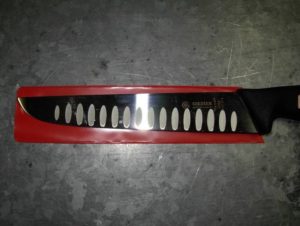Choosing a knife
Well-designed knives have features that assist in safer cutting with less force. To stop the hand slipping down the knife, look for:
- an easy to clean non-slip handle; for example glass filled nylon, textured plastic, a finger loop in handle
- a hilt guard, there are several types; for example samurai or sabre style, a + or T shaped guard.
To enable a cut to be made with less exertion, look for:
- grooves in the blade – grooves break the vacuum during the cut and reduce the force needed for the cut
- a hard steel alloy blade – these blades keep a sharp edge for longer and require the use of a knife sharpening machine
- a strong, thin, flexible blade – This reduces the reaction force in the wrist due to blade bending while cutting.
To ease hand or wrist strain, look for a handle that:
- has been shaped to reduce excessive bending of the wrist
- is not too long for the job as a knife that is too long for the job places extra strain on the wrist and forearm
- is the right size for the hand – the handle needs to be large enough in diameter to reduce the tendency for an excessively tight grip, but not overly large for an inadequate grip
- is suitable for left or right handed use.
Scalloped blades
Scalloped blades are particularly good when cutting dense meat like pork or fat meat. The scallops reduce friction and drag and produce an air cushion reducing adhesion to the fat or meat. Scalloped knives come in various designs from boning / trimming to large steak knives.

Scallops reduce drag and produce an air cushion
Avoiding injury when sharpening knives
To avoid injury when sharpening knives:
- when using a sharpening stone, make sure the stone is on a slip-proof, flat surface
- when using a stone, always keep your free hand away from the stone and knife. Invest in a pair of cut resistant gloves even an old pair is better than nothing
- make sure your steel has a safety guard between the handle and the body of the steel
- when using a grindstone, make sure the rotation of the stone and the cutting edge of the blade are away from your body
- if you drop your knife, let it fall, don’t try to catch it
- always place your knife in the scabbard or pouch when not in use – it should not be left laying around benches and handbasins, etc.
- always use a sharp knife as you will need to use more force with a blunt knife and will have less control
- if you must look away, stop cutting – never take your eyes off the cutting path of the knife
- never cut towards yourself or towards another individual
- always be aware of the movement of people around you
- never fool around with a knife in your hand or fool around with others who may have a knife in their hand
- always keep the handle of the knife clean and free of fat and grease
- always use mesh or cut resistant gloves as required in the work instructions
- take care when washing your gear at the end of the day. Many cuts have been the result of someone feeling around in the soapy water for a dropped knife. Wash them one at a time and don’t let go
- make sure when transporting knives around site they are in their pouch (no steeling while walking)
- always place knives in pouch when not in use. Do not leave knife on benches and hand basins, etc.
- dismantle pouch to ensure effective sterilisation of pouch and knives at the end of your shift.
